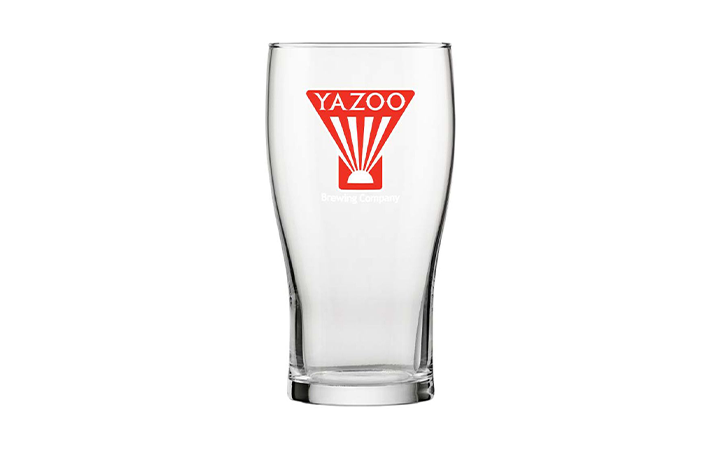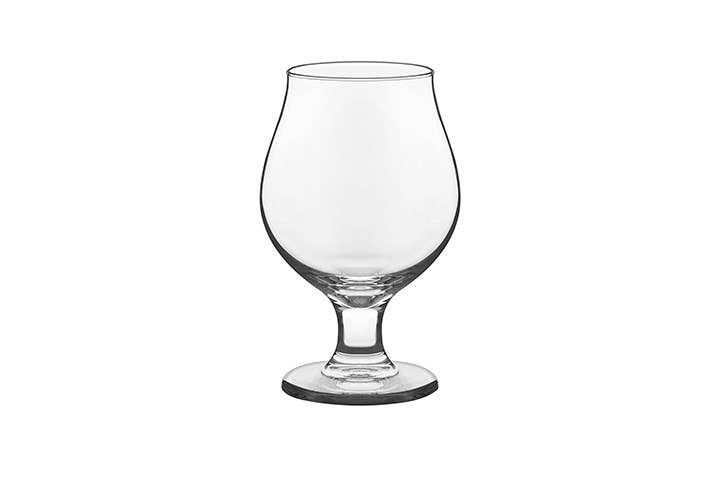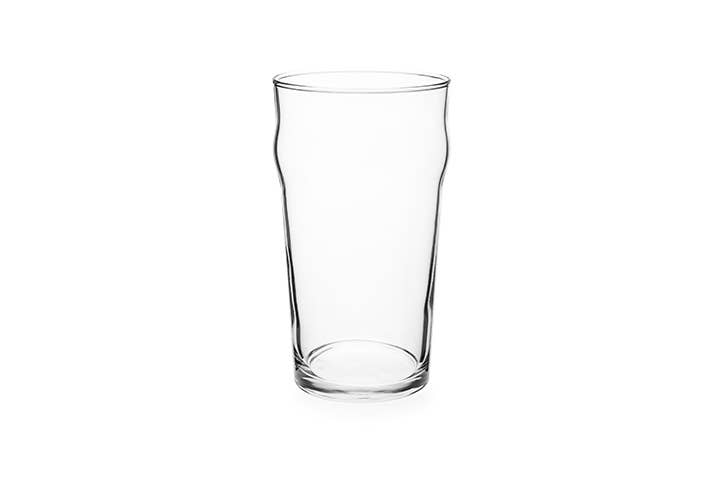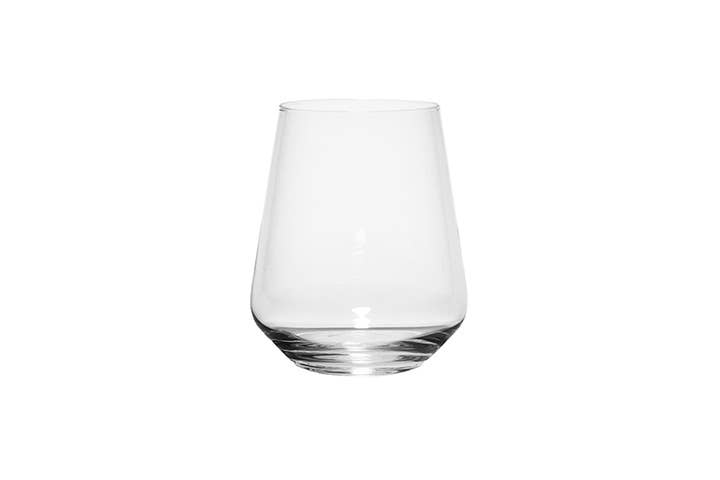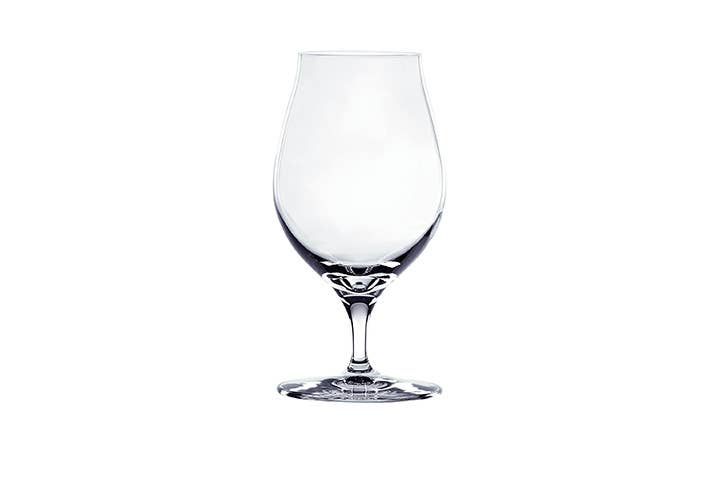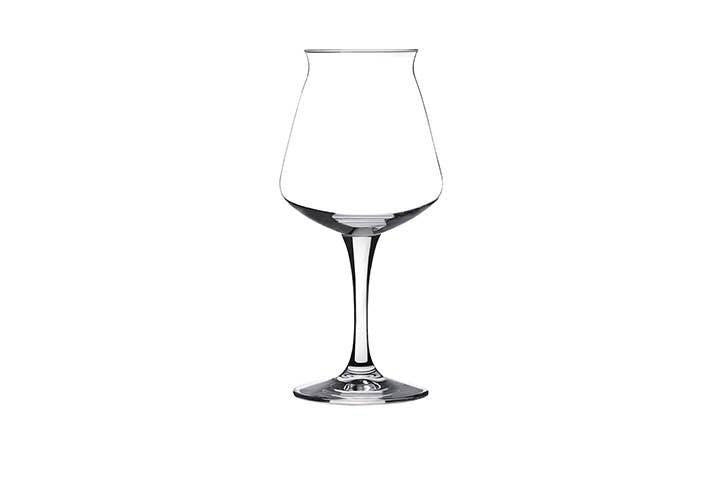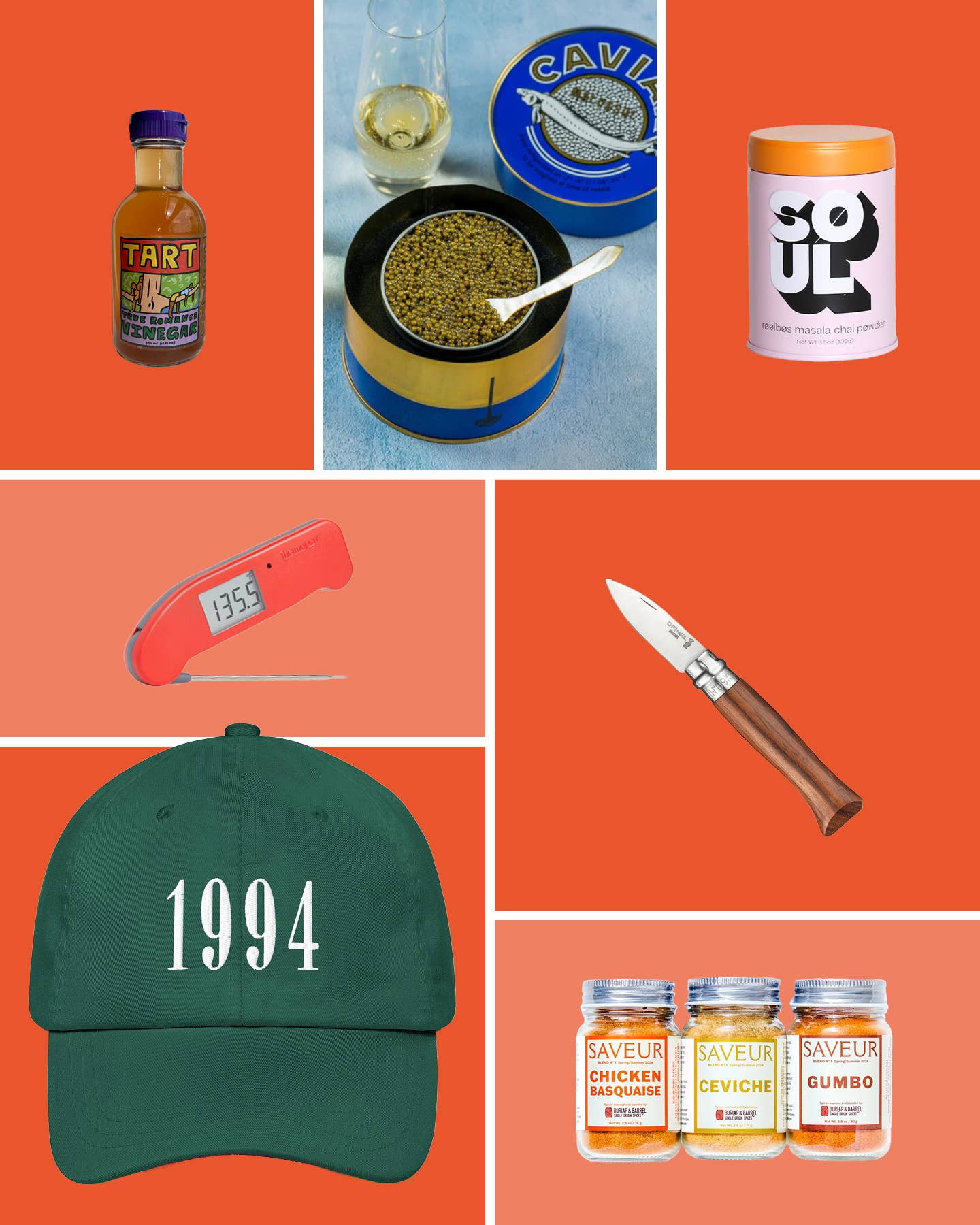We Talked to Brew Masters and Hop Nerds To Find the Best Beer Glasses
These are the vessels that the professionals stock up at home, and at their taprooms.
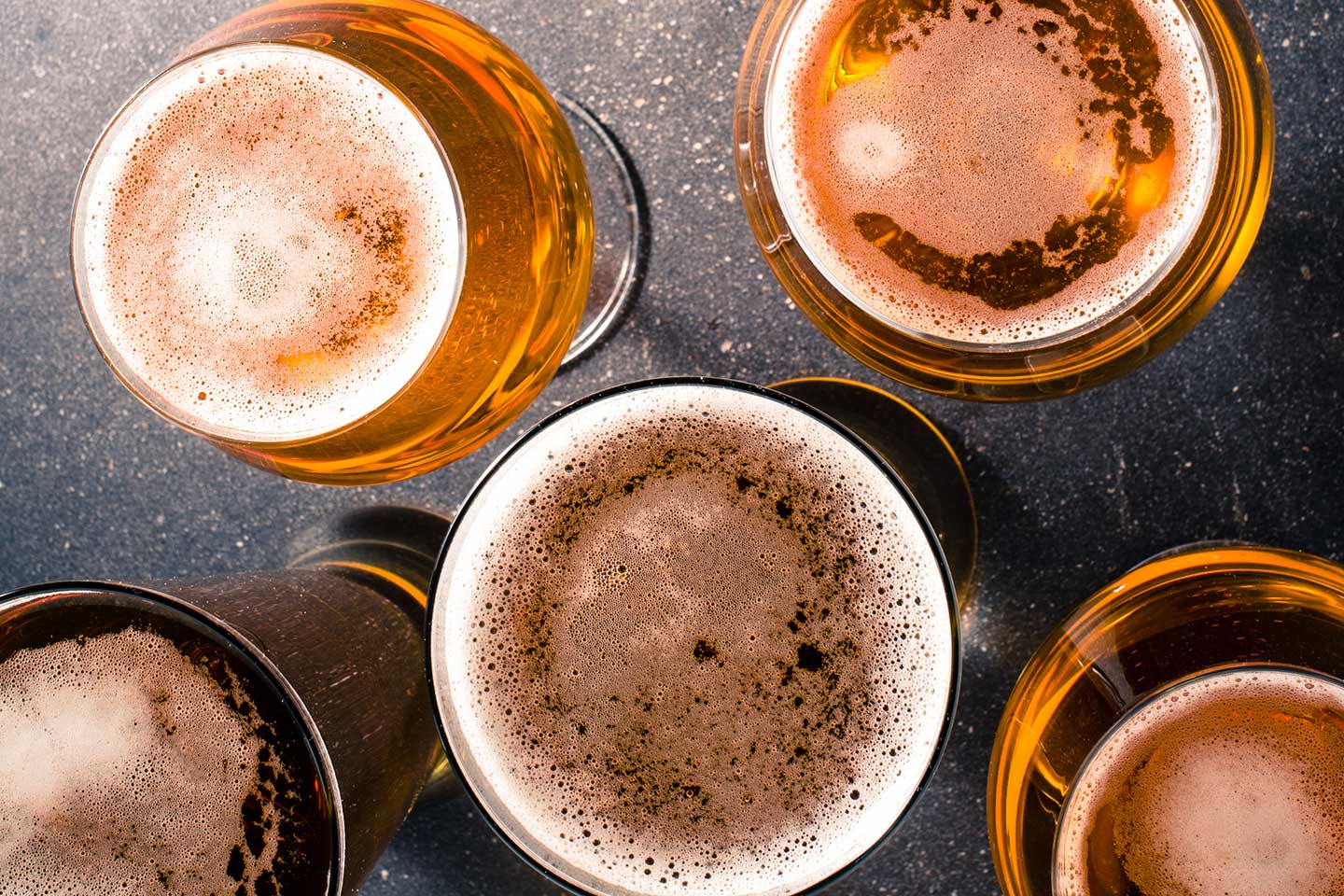
Step inside and saddle up to the bar of any brewery, taproom, or pub, and your beverage of choice will always arrive in an appropriate vessel. Serving each beer in the right shape of glassware—even if only the most versatile pint glass—is a crucial part of the overall tasting experience. Take it from Firestone Walker’s brewmaster Matt Brynildson, who says before we even take that first sip, we’re already drinking the brew in with our eyes, immediately noticing the color and billions upon billions of bubbles. “Unlike still wine, beer possesses the effervescence of carbonation, and great beer has a beautiful, long-lasting foam,” he explains, which is why the best beer glasses are roomy enough for the fizz to lift and hold up a pour’s frothy head where all the aromatics live.
Being served the best beer glass from the experts versus stocking up your own home bar, however, can be a bit complicated, especially when you start considering all of the options available today. In recent years, the craft beer scene has more or less exploded, and the proof can be found in the increase of beer subscription boxes or options available at your local grocery store, which likely expanded from a fridge of classic, mainstream lagers, to local ales and all sorts of crazy combinations like fruit and spice beers to barrel-aged barleywines. Whatever you do, don’t stress—while pouring the perfect pint should have all the theatrics customary to the wine world, according to Brynildson, most of the best beer glasses are versatile enough to support a range of styles as opposed to just a single variety. That’s why our list below spotlights versatile picks recommended by a few of the industry’s professional makers and tasters.
Our Top Picks
- Best for Lagers and IPAs: Willi Becher Tumbler Glass
- Best for Stouts: Libbey Craft Brew Snifter
- Best for Classic Ales: Nonic Beer Pint Glass
- Best for Sours: Rastal Harmony Tumbler
- Best for Specialty Brews: Spiegelau Tulip Glass
- Best for All of the Above: Rastal Teku Stemmed Beer Glass
Best for Lagers and IPAs: Willi Becher Tumbler Glass
Best for Lagers and IPAs
Capacity: 16 ounces | Style: Pint | Dishwasher-Safe: Yes
Pros
- Versatile
- Durable, heat-treated glass
- Can be customized
Cons
- Numerous makers to buy from, with slight variations to the glass
Why we chose it: For everyday enjoyment, this is leaps and bounds better than a boring shaker.
A must-have, go-to glass of both taprooms (you’ll see it at Firestone Walker locations and Heater Allen, an Oregon-based brewery specializing in lager beers) and home bars, the Willi Becher is a classic, German option. “This is a very standard glass that a lot of breweries and taprooms use because it is a great, all-around glass that is far superior for smelling and tasting beer than the ubiquitous shaker pint,” shares Lisa Allen, head brewer at Heater Allen. “We have a 100mL line on our Willi Bechers that we pour samples to, which allows the taster to actually get their nose in the glass and smell the beer.” Experts also note it’s a solid glass suitable for hazy IPAs, pale ales, English-style ales, brown ales, and more.
Best for Stouts: Libbey Craft Brew Glass
Best for Stouts
Capacity: 16 ounces | Style: Tulip | Dishwasher-Safe: Yes
Pros
- Short stem
- Thick glass
- 3.75-inch diameter
Cons
- Cheaper to buy a set of four
- Keep out of the freezer
Why we chose it: For bold-bodied stouts.
For friends and family, Billy Garza, a brewer of Weathered Souls Brewing Co.—founded by head brewer Marcus Baskerville in San Antonio—recommends a snifter for stouts. The wide, rounded style of this glass is ideal for letting barrel-aged and blended stouts, like the Anniversary Beer (with a 14.5 percent ABV), breathe. “The shape and open mouth really let you appreciate the intense notes found in those styles,” adds Garza, whether it’s something sweet and creamy like chocolate and coffee, or a bit more robust, to detect the nutty notes of what is often a very dark and very dense beer. Lighter stouts, on the other hand (like Guinness), can be poured into a regular old pint glass, such as the nonic pint below.
Best for Classic Ales: Nonic Beer Pint Glass
Best for Classic Ales
Capacity: 20 ounces | Style: Pint | Dishwasher-Safe: Yes
Pros
- Stackable
- Quality, soda-lime glass by Bormioli Rocco
- Holds a couple of ounces more than the American equivalent
Cons
- Sold as a set of 12
Why we chose it: An iconic, svelte staple for all your ales.
For pale ales, brown ales, and red ales, as well as lighter stouts and porters, the nonic pint glass is your best bet. Similar to a shaker, the bulged silhouette near the head is almost synonymous with English pubs, but is better at capturing a beer’s aroma, even American IPAs. It’s the glass of choice for all of Firestone Walker’s classic ales, including its malty flagship Double Barrel Ale. Garza also pours smooth Irish stouts and roast-y porters into a nonic pint. While the shape captures flavor quite well, it also serves an incredibly practical purpose: it’s easier to lose your grip on a slippery shaker than a bulbous nonic pint, which is easier to hold and less likely to break (or get nicked, hence the name) from a tumble.
Best for Sours: Rastal Harmony Tumbler
Best for Sours
Capacity: 13.5 ounces | Style: Stemless | Dishwasher-Safe: No
Pros
- Lightweight
- Sturdy, stemless bottom to limit spills
Cons
- Smaller volume designed for white wine
Why we chose it: A glass that does double duty, but with a narrow enough top to catch all the complexities of a soured beer.
While all beers are hiding nuanced flavors, sours can come off as particularly complex. Sour beers, commonly made with Berliner weisse or a gose, are often associated with being as tart as sipping on grapefruit juice, but can also be softened with honey and spices, even taking on a smoothie-like weight and taste. With a reputation for whipping up fruited sours, Talea, a female-founded brewery in Brooklyn, New York, sticks to the narrow opening of Rastal Harmony stemless wine glasses when dishing out flights. “It's a multi-purpose glass originally designed for wine but we love it for our beers,” explains co-founder Tara Hankinson. “The tapered top concentrates aromas and the bright crystal shows off our colorful fruited sours. The glass is lightweight but very durable for our high-volume taproom. While we love stemmed glasses for their elegance and keeping your beer cool, they aren’t practical for carrying multiple at a time.”
Best for Specialty Brews: Spiegelau Tulip Glass
Best for Specialty Brews
Capacity: 15.5 ounces | Style: Tulip | Dishwasher-Safe: No
Pros
- Elegant, thin glass
- Holds foam well
Cons
- A bit delicate
Why we chose it: Feels like a high-end wine glass; count on it for when the ABV passes single digits.
This is for the specialty beers—think double IPAs, imperial stouts, saisons, honey meads, and fancy fruit beers, even a few Belgian styles—that pack a punch. The stem enables a good swirl to really release the aromatics and the clarity of the glass ensures any beer is presented beautifully. It’s a personal favorite of many brewers we spoke with, including Jordan Gardenhire, founder of Baja Brewing, the original craft beer of Los Cabos Baja. While this particular pick is a bit bigger than Gardenhire’s preferred 12 ounces, the flared top is what’s key. “It helps hold a nice head, but also sports an aroma-catching body,” Gardenhire continues. “It's sturdy and aesthetically can really be used for almost any beer, in my opinion.”
Best for All of the Above: Rastal Teku Stemmed Beer Glass
Best for All of the Above
Capacity: 14 ounces | Style: Tulip | Dishwasher-Safe: No
Pros
- Hand-blown glass
- Titanium-reinforced stem
- Freezer safe
- Contemporary design
Cons
- Hand-washing preferred
Why we chose it: Feel like a beer aficionado, no matter what can or bottle you’re pouring.
Described as having a chimney-shaped bowl, the Teku beer glass is a universal people pleaser. It brings together all the best features of a beer glass—a curved, rounded body, a narrow, flared, and thin-rimmed mouth to help detect every aroma, and a sturdy, durable, yet elegant stem longer than your typical tulip to keep your hands off the glass and your beer cool. It’s a design that promises to make your beer both smell and taste better. If you want to really analyze the taste of your beer, you can’t go wrong with a Teku style, especially this nucleated version with an etched bottom to better retain carbonation.
We Also Like
- Dimpled mugs and solid steins aren’t just for beer gardens and Oktoberfest—they’re used by numerous taprooms to serve lagers and lighter ales of all kinds. Keep your grip on the handle, and you won’t have to worry about your palm warming up your drink.
- If you’re looking to pour your IPA in something a little different, Spieglau’s 18-ounce glass with a rippled, stem-like bottom is great for showing off hop-forward brews. Created in collaboration with Sierra Nevada’s Ken Grossman and Dogfish Head’s Sam Calagione, this shape is hoping to come onto the scene as the new standard.
- Brynildson never hesitates to pull out his Zalto wine glasses for extra-special pours, whether it’s a highly carbonated, conditioned saison, a complex IPA, or a malty, old-world English bitter. “They present the flavors and aromas well, just as they do for wine. I prefer the less bowl-like, taller shapes that hold foam better, but still allow you to swirl and bring the aromas into the headspace, so white wine glasses work well,” he explains, though adds the company recently released a beer-specific glass that fits the bill, too.
- An Omar Becher is the kind of glass that you’re more likely to see overseas in Belgium’s brown pubs, serving saisons and pilsners, as the small glass is versatile for the country’s range of the light bodied to the funky, and is a special addition to Brynildson’s personal collection. “I’ve been told that the ribs were built into the glass to keep your hand from warming the beer inside,” he shares.
- Ever been to Cologne, Germany? Then you’ll recognize the slender silhouette of a Rastal Kolsch Tumbler. Impress your guests with this unusual shape designed to specifically hold small, recurring pours of the region’s light and crisp delight, Kölsch. But Bryndilson enjoys other zippy beers in it too, like Helles and pilsners.
How We Chose These Products
To put together our list of the best beer glasses, we consulted the experts—brewmasters, brew hands, tasters, and writers—and asked both what their businesses use to serve drinks in, and what they’ve added to their own collection at home. Thankfully, nearly all of their picks are versatile, suitable to a number of beers as opposed to just one style.
Features to Keep in Mind When Shopping for Beer Glasses
Types of Beer Glasses
Today, there’s a glass and shape for every type of craft brew—some experts even argue that depending on the type of IPA you’ll need a different shape (a hazy, American-style IPA is suited just fine to a nonic pint, but for bolder doubles or imperials with a higher ABV, a rounded goblet-like tulip is best). The most popular glasses you should be familiar with include:
- Pint: The classic, American pint glass is simple and probably the shape you’re most familiar with—it’s usually 16 ounces and features a wider mouth that tapers to a narrow bottom. Affordable and easy to clean, it’s the glass most frequently seen at restaurants. But the experts we spoke to prefer the larger, English version—otherwise known as a nonic pint—especially if flavor is what you're after. It has the same tapered look, but with a bubbled top, that not only makes it easier to stack and hold, but caresses the aroma of your beer as opposed to letting it fizz out.
- Mug: A mug is usually a beer glass with a handle, or the more traditional, thick-walled German stein, both of which are great at keeping your brew cool. It’s usually characterized by a dimpled body or a thick silhouette that’s sorta rectangular in nature.
- Tulip: Similar to a goblet, the tulip glass has origins in Belgian beers and is defined by its squat stem and curved, wide sides that mimic the very flower it's named after (also a well-known Belgian import). Most include a flared rim for a more concentrated release of smells. Similar iterations include a snifter, more popularly used to serve brandy, for the same bulbous body, and the thistle, which is the Scottish equivalent. They come in a range of sizes, from a standard 16-ounce pint to a small, 5-ounce taster.
- Weizen: Typically 20 ounces, a Weizen glass is for wheat beers, like a Hefeweizen, hence the thick, bulbous top but tall height and slender middle. While it does have the same look and feel to it as a pilsner glass, it’s not the same (plus, pilsners aren’t always served in a lofty, slender style, but also come in a stemmed version).
Though, here’s the thing—nearly everyone we spoke to agrees you don’t need to amass all of the above. Just invest in the styles that you love and enjoy the most at home. The other caveat? “A lot of it is just marketing,” writer Justin Kennedy tells us. “No one really needs an IPA-, stout-, or hefeweizen-specific glass. I prefer just a few types of glasses for all my beer: a plain stemmed wine glass for saisons and strong beers, a dimpled mug for lagers, and a Willi Becher pint for English-style ales and IPAs. If you only want to buy one beer glass, make it the Spiegelau Stemmed Pilsner Glass—it’s nearly perfect for any style.”
Shape and Size
The biggest takeaway when searching for a beer glass is its tapered, bubbled, or bowl-like shape. It’s not just for aesthetics. We Talked to Brew Masters and Hop Nerds To Find the Best Beer GlassesThis is specifically done to concentrate aromas for an overall more enjoyable tasting experience because smelling really is important; get a good whiff before you take a sip.
“Glass size and shape influence aroma and taste by helping to accent and promote certain qualities of a particular beer. Just like with wine, certain beer glass shapes are geared toward certain beer styles,” shares Allen. “When the proper glass is used it will help bring out the subtle aromas and flavors in a beer. Drinking out of the proper glassware can elevate a beer drinking experience and show the more nuanced aspects of a beer.”
Brands
You may have noticed that a few brands appear more than once for our top picks and general favorites, chief among them Rastal, Libbey, and Spieglau. Designed in Germany, Rastal is known for its modern range of drinkware; Libbey is an American company that’s been around since the early 1800s; and Spieglau is even older (we’re talking 500 years), offering nearly every style of beer glassware you can buy.
Uniqueness and Customization
Think of finding the best beer glasses like putting together a collection of souvenirs. “Unlike snobby winos, beer people value eclecticism and originality in both the product we drink and the glassware we use,” argues Gardenhire. “Brewpubs often have fantastic glasses for sale that can be fun for you and your guests. Think more college, less cribbage.”
Maintenance
A tip from the pros: Rinse your glass down before and after you drink. “Like they do at the bar with upside-down jet spray,” Kennedy points out. It will remove any dust, dirt, or lingering detergent residue. And if you aren’t going to wash your glass as soon as you're done, a quick wipe will work wonders in the long run. “Keeping your beer glass clean is of paramount importance,” adds Brynildson, who suggests skipping the dishwasher and sticking to warm soapy water. “An unclean beer glass will result in bubbles clinging below the liquid line and the foam will collapse quickly.”
Ask an Expert
Q: Does glassware actually impact taste?
“Glassware impacts the tasting experience of beer immensely, just as it does for wine,” shares Brynildson. That’s why there are so many variations and shapes to choose from, and those specifically designed to serve a single style of beer, like an extra-tall footed pilsner, which best shows off the beer’s clarity. And if you’ve ever indulged in a flight of beer at a brewery, even the smaller glasses are designed to capture the essence of the pour. For tasters, Firestone prefers to use the Glencairn whisky glass, but you’re more likely to come across small-scale tulips that hold around five ounces.
Q: Is it better to go with thin or thick glass?
This really depends on personal preference, or just how dainty you want to be when drinking your beer. Thin, lightweight glass, though lovely to look at, is less likely to hold up after time. “I've broken so many glasses from just being in my cabinets that I now look for thick glasses,” suggests Garza. “I don't want to be cautious when enjoying my beers or cleaning after.”
And while Kennedy prefers the feel of a thin glass, if you’re prone to breaking them, investing in one can be a waste; a thicker glass is more likely to last a lifetime. “You’re sacrificing thinness and elegance, but in the end, it’s just beer,” Kennedy notes. “The most expensive beer you’re going to drink is probably in the dozens of dollars range, anyway, so there’s really no need to splurge on fancy glassware.”
Q: What’s the average pour of beer?
The classic pint, according to Gardenhire, is 16 ounces. Properly pouring said beer, however, is all about gusto. You want to release the carbonation, not hide it, contrary to popular belief. To create that foamy head, start by pouring into a tilted glass at a 45-degree angle, and then about halfway through, gently bring it upright.
“A proper pour is essential as you want to make sure there is enough head on the beer to trap the aroma, which will make that first smell and sip the best,” Gardenhire adds. “As you drink down the pint, some head can remain, keeping some of the aroma around throughout the beer. But the first sip is the best, so take it all in.”
Our Take
“At the end of the day, drinking is a sensory experience, and experiencing the visual identity of your beverage is key,” stresses Harkinson, who recommends investing in glassware you love. The best beer glasses, in other words, can make every can or bottle a special occasion.
Keep Reading
Continue to Next Story
